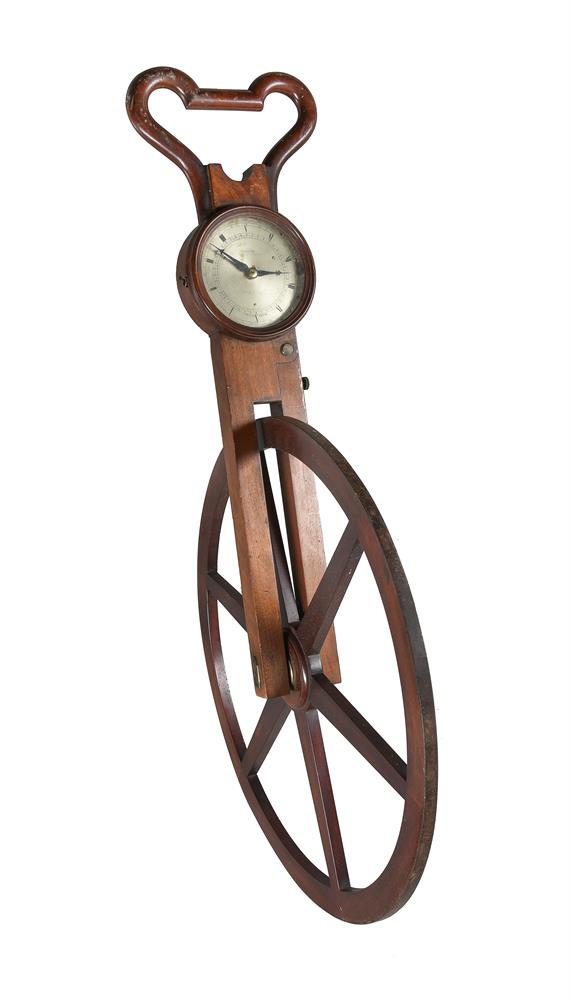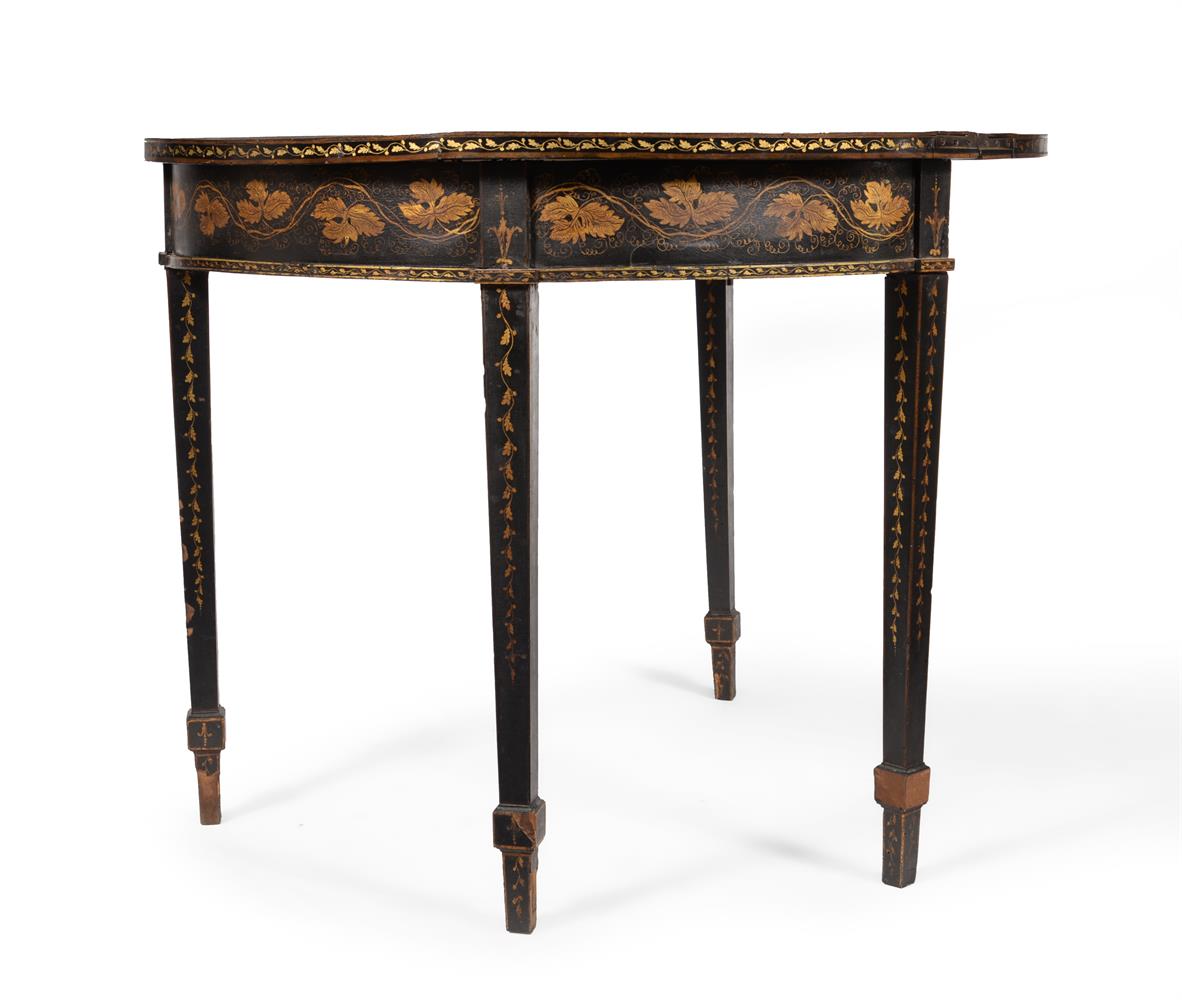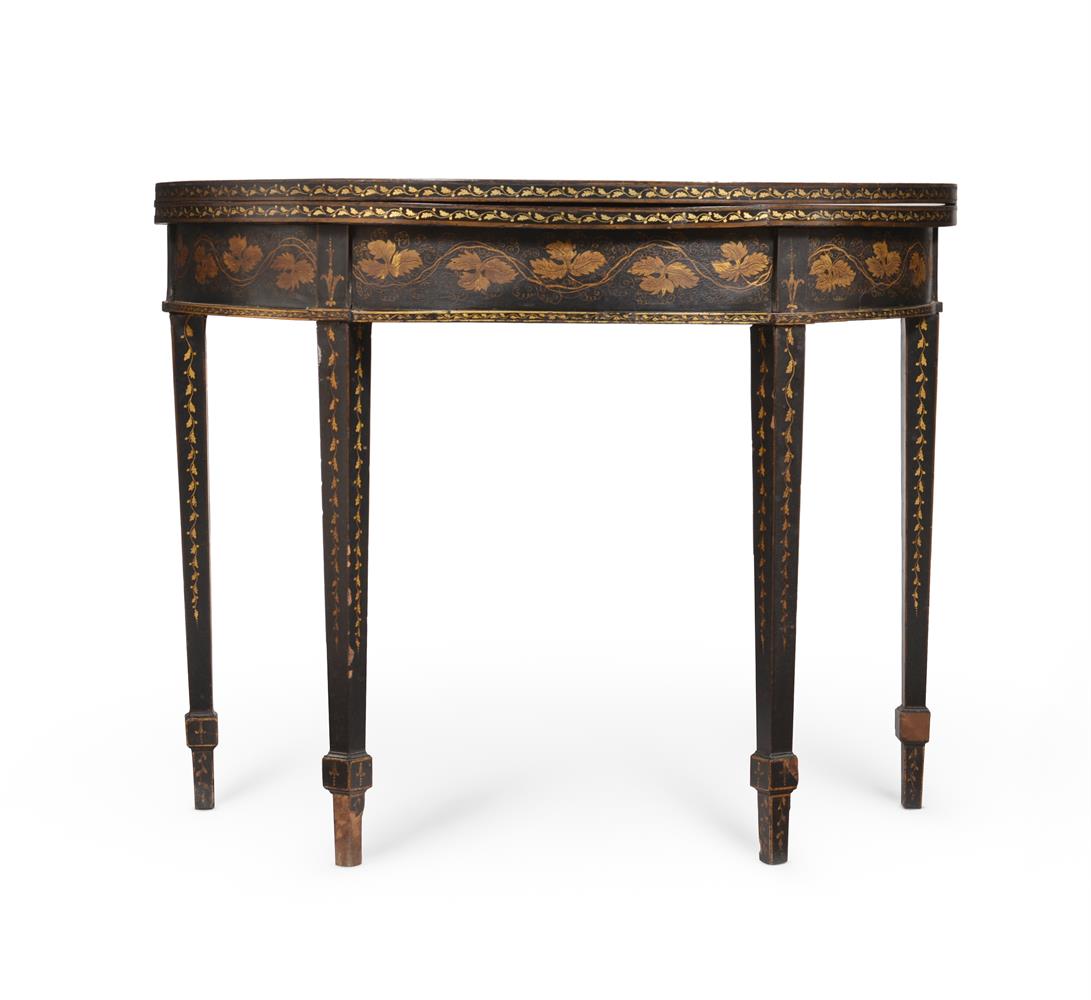A RARE GEORGE III BLACK JAPANNED AND POLYCHROME DECORATED SEMI ELLIPTICAL FOLDING TEA TABLE BY HENRY CLAY, LAST QUARTER 18TH CENTURY Veneered in papier mâché and painted, the top with neoclassical reserves and with Grand Tour style vignettes within bands of Roman style profile portraits, the interior with a Chinoiserie scene, the whole with 73.5cm high, 92cm wide, 46cm deep (when closed) The discovery of this rare table is an important addition to the very small number of known examples of furniture produced by the Birmingham manufacturer, inventor and entrepreneur Henry Clay (1738-1812). In 1776 Edward Daniel Clarke noted in his book that he had visited Clay- and seen two pier tables for Lord Bristol, "which were painted after some designs brought purposely from Rome". These tables for the 4th Earl disappeared until 1987 when two appeared at Christie's London with two further appearing in 2005 and two more known to be in a private collection. The Bristol tables were designed with decoration to the top in two styles. Either fully painted scenes of Italianate landscapes- or in the Pompeian manner with vignettes within formal borders with medallions of profile human and animal heads and with central medallion of Cupids sacrificing at an altar, while crowning a roundel portrait of Beatrice Cenci as seen in the Palazzo Barberini. This table corresponds to the second form of decorative design. A papier mâché tray in the Birmingham Museum stamped Henry Clay has this exact design- presented as an oval- which is how this table design would appear if two such tables were placed back-to-back. The frieze and top and legs are veneered in what Clay referred to as "panel"- his 1772 patented version of 'stoved', or baked, japanning on papier mâché. Whilst the location and existence of the Bristol tables is recorded- it is also known that Clay carried out commissions for other similar examples of furniture and tables. Most notably it was said that he presented a pair of pier tables to Queen Charlotte, the wife of George III. There appears to be no trace of such tables in the Royal Collection but it seems that many pieces purchased by Queen Charlotte were later sold. The gift had been made with a view to currying favour and further commissions from the Queen, her retinue and the court. It is a tantalising possibility that this table may be from one such commission. The interior decoration on this table, especially the execution of the trees, may be compared with the Clay panel sold by Woolley & Wallis, 11 November 2008, Lot 365. The pendant heads bear comparison with the doors in the Marble Hall, at Keddleston Hall in Derbyshire (pl.11 p21 in "Japanned Papier Mache"). We are most grateful to Yvonne Jones for her assistance and suggestions with cataloguing and researching this table. Related Literature: Yvonne Jones, 'A recent discovery of two papier mâché pier tables by Henry Clay', The Furniture History Society Newsletter, no. 162, May 2006 Yvonne Jones, 'George Brookshaw - Japanner! Further light on japanned metal and papier mâché furniture c. 1740-c. 1820', The Furniture History Society Newsletter, no. 173, February 2009 Yvonne Jones, 'Japanned papier mâché and tinware c.1740-1940', pp.128-130, Woodbridge, Antique Collectors' Club, 2012 Condition Report: Wear, abrasions and loss from use, handling and as per age. The surface uniformly with build up of surface dirt and varnish(?) discolouration. The main top with undulations from carcass movement. Streaky patches of surface that might be from old water spillage. Interior much better condition. Some rubbing to exposed gilded details Structurally- all 4 legs have been off at one time or another. Back two with modern metal strip bracing, 1 front with underframe block repair- the other with cruder nail repair. Losses to veneer most notably to extremities and exposed edges notably back corners, feet and top and frieze margins Please see numerous additional images for visual references to conditio
A RARE GEORGE III BLACK JAPANNED AND POLYCHROME DECORATED SEMI ELLIPTICAL FOLDING TEA TABLE BY HENRY CLAY, LAST QUARTER 18TH CENTURY Veneered in papier mâché and painted, the top with neoclassical reserves and with Grand Tour style vignettes within bands of Roman style profile portraits, the interior with a Chinoiserie scene, the whole with 73.5cm high, 92cm wide, 46cm deep (when closed) The discovery of this rare table is an important addition to the very small number of known examples of furniture produced by the Birmingham manufacturer, inventor and entrepreneur Henry Clay (1738-1812). In 1776 Edward Daniel Clarke noted in his book that he had visited Clay- and seen two pier tables for Lord Bristol, "which were painted after some designs brought purposely from Rome". These tables for the 4th Earl disappeared until 1987 when two appeared at Christie's London with two further appearing in 2005 and two more known to be in a private collection. The Bristol tables were designed with decoration to the top in two styles. Either fully painted scenes of Italianate landscapes- or in the Pompeian manner with vignettes within formal borders with medallions of profile human and animal heads and with central medallion of Cupids sacrificing at an altar, while crowning a roundel portrait of Beatrice Cenci as seen in the Palazzo Barberini. This table corresponds to the second form of decorative design. A papier mâché tray in the Birmingham Museum stamped Henry Clay has this exact design- presented as an oval- which is how this table design would appear if two such tables were placed back-to-back. The frieze and top and legs are veneered in what Clay referred to as "panel"- his 1772 patented version of 'stoved', or baked, japanning on papier mâché. Whilst the location and existence of the Bristol tables is recorded- it is also known that Clay carried out commissions for other similar examples of furniture and tables. Most notably it was said that he presented a pair of pier tables to Queen Charlotte, the wife of George III. There appears to be no trace of such tables in the Royal Collection but it seems that many pieces purchased by Queen Charlotte were later sold. The gift had been made with a view to currying favour and further commissions from the Queen, her retinue and the court. It is a tantalising possibility that this table may be from one such commission. The interior decoration on this table, especially the execution of the trees, may be compared with the Clay panel sold by Woolley & Wallis, 11 November 2008, Lot 365. The pendant heads bear comparison with the doors in the Marble Hall, at Keddleston Hall in Derbyshire (pl.11 p21 in "Japanned Papier Mache"). We are most grateful to Yvonne Jones for her assistance and suggestions with cataloguing and researching this table. Related Literature: Yvonne Jones, 'A recent discovery of two papier mâché pier tables by Henry Clay', The Furniture History Society Newsletter, no. 162, May 2006 Yvonne Jones, 'George Brookshaw - Japanner! Further light on japanned metal and papier mâché furniture c. 1740-c. 1820', The Furniture History Society Newsletter, no. 173, February 2009 Yvonne Jones, 'Japanned papier mâché and tinware c.1740-1940', pp.128-130, Woodbridge, Antique Collectors' Club, 2012 Condition Report: Wear, abrasions and loss from use, handling and as per age. The surface uniformly with build up of surface dirt and varnish(?) discolouration. The main top with undulations from carcass movement. Streaky patches of surface that might be from old water spillage. Interior much better condition. Some rubbing to exposed gilded details Structurally- all 4 legs have been off at one time or another. Back two with modern metal strip bracing, 1 front with underframe block repair- the other with cruder nail repair. Losses to veneer most notably to extremities and exposed edges notably back corners, feet and top and frieze margins Please see numerous additional images for visual references to conditio















Testen Sie LotSearch und seine Premium-Features 7 Tage - ohne Kosten!
Lassen Sie sich automatisch über neue Objekte in kommenden Auktionen benachrichtigen.
Suchauftrag anlegen